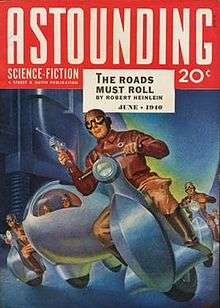The Roads Must Roll

"The Roads Must Roll" is a 1940 science fiction short story by American writer Robert A. Heinlein. It was selected for The Science Fiction Hall of Fame, Volume One, 1929–1964 anthology in 1970.[1]
The story is set in the near future, when "roadtowns" (wide rapidly moving passenger platforms similar to moving sidewalks, but reaching speeds of 100 mph) have replaced highways and railways as the dominant transportation method in the United States.
Heinlein's themes are technological change and social cohesion. The fictional social movement he calls functionalism (which is unrelated to the real-life sociological theory of the same name), advances the idea that one's status and level of material reward in a society must and should depend on the functions one performs for that society.
Plot summary
Larry Gaines, Chief Engineer of the Diego-Reno roadtown, is dining in a moving restaurant on the road when one of the moving sidewalk strips unexpectedly stops, causing injuries to the thousands of commuters on it. Gaines learns that it was sabotage. The technicians who maintain the Stockton section of the road have been persuaded by a radical social theory, Functionalism, that their role in maintaining the nation's transport infrastructure is more important than that of any other workers and that they should therefore be in control. The roads are managed by the Transport Cadets, an elite paramilitary organization formed by the US Military to keep this crucial infrastructure running. The rebels have stopped the strip as a demonstration to encourage their fellow technicians around the country to rebel against the Cadets, and start the Functionalist Revolution.
Going into the machinery under the roadway that runs it, Gaines takes command of the response. He doesn't order the Road stopped, since that would leave millions of commuters stranded, but instead has the military evacuate the riders, a time-consuming procedure. In command of a hastily gathered corps of armed cadets, he proceeds up the underground access tunnel toward Stockton, on "tumblebugs," motorized and gyroscopically stabilized unicycles much like the later real-life Segway. As the military advance proceeds, they arrest rebel technicians and cross connect the wiring of the machinery, motor by motor, to take control away from the rebels in the Stockton office.
Gaines calls the Stockton office and learns that the leader of the rebellion is "Shorty" Van Kleeck, the chief deputy engineer of the Sacramento sector. Over the videophone Shorty threatens to kill millions of people with a button that he has rigged to blow up the Road if Gaines doesn't capitulate. Gaines doesn't understand how Shorty has gotten so many technicians to side with him; psychological screening tests are supposed to guarantee that technicians don't have the temperament to revolt. Then Gaines realizes that Deputy Shorty was able to move revolution-prone workers into his sector because, as deputy, Shorty had access to the psychological files on the technicians. Gaines accesses Shorty's psychological profile and studies the neurotic traits that have made him a demagogue.
Asking for a parley, Gaines is taken to the Stockton office and faces Shorty. There he uses his knowledge of Shorty's psychology to push him into a nervous breakdown, and overpowers him, gaining control of the 'suicide' button. The Cadets attack the office and the rebellion is ended.
Later, Gaines ponders the changes that will have to be made to make sure there is never a recurrence of these events: more psychological testing, more careful oversight, and more esprit de corps. He concludes that the price of high tech transportation like the Roadways is eternal vigilance.
Roads
Heinlein's vision of a Road, always capitalized, was a fully enclosed Slidewalk or multi-speed conveyor belt whose cargo was people and freight, stretching from city to city, and operating at maximum speeds of 100 miles per hour. The Road City was a consequence of this, clearly noted in the story, where people whose livelihood depended on the Road began to live in new communities built along its length. Factories were located along the Road because of easy transport for their goods and materials. Entire businesses established themselves on the conveyor strips to cater to travelers while they moved from city to city, and the people who worked in those business lived within easy reach of the Road itself, living in "the country" but working in "the city".
At the time of writing, the "flight to the suburbs" had not yet taken place in the USA. Superhighways were known from the example of German autobahns but had not taken hold. Heinlein predicted that superhighways would cause what is now called urban sprawl along their routes, and the Road City took the concept further by having the transportation become the core of the urban development.
In Heinlein's Future History, the Road Cities succumb to even more technological progress and social change. In The Man Who Sold The Moon D. D. Harriman calls them "moribund". In Methuselah's Children they are empty relics littering the landscape.
Themes
Damon Knight, in his introduction to the paper-back edition from the New English Library edition of The Past Through Tomorrow, Vol 1., compares the story to the then-current power of Jimmy Hoffa and the Teamsters Union. He also notes that Heinlein successfully predicted urban sprawl driven by cheap and efficient transport, as well as the development of 'pseudopods' of urban development between communities.
Adaptation
"The Roads Must Roll" was adapted for the radio shows Dimension X in 1950 and X Minus One in 1956.
See also
Notes
- ↑ Silverberg 1970, p. xii
Sources
- Silverberg, Robert, ed. (1970), The Science Fiction Hall of Fame, Volume One, 1929–1964, Tom Doherty Associates, ISBN 0-7653-0537-2
External links
- The Roads Must Roll title listing at the Internet Speculative Fiction Database
- The Roads Must Roll Radio Play from 1950